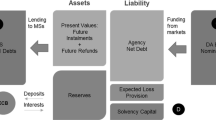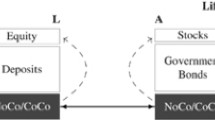Abstract
This paper analyses the interactions between the financial and the real sector in an environment where liquidity holdings is an input of the credit/investment process. The supply of liquidity is constrained in that income pledgeability limits inside liquidity, and there is a range of outside liquidity instruments that differ for safety and liquidity. We analyse the resulting equilibrium asset prices, collateral/liquidity-safety premia, liquidity instrument holdings and real investment. The model is applied to examine the implications of liquidity provision policies and debt management in the Euro Area. We analyse how the correlation structure of the bond market values affects the optimal composition of liquidity instrument holdings and prices, and formalize the concept of a European Safe Bond with a clear analysis of its potential advantages.





Similar content being viewed by others
Notes
Krishnamurthy and Vissing-Jorgensen (2012) document that Treasuries offer money-like convenience services and these services are reflected in the pricing of Treasury securities. Von Hagen and Fender (1998) document the growing relevance of liquidity in nowadays financial systems and the broadening of monetary aggregates.
The importance of secured/collateralized government debt for a sounder euro area monetary system is emphasized by Nyborg (2011). The euro-nomics group (2011) points out the vital importance of a European safe asset for the long run survival of the euro-zone and calls for the creation of European Safe Bonds, where safeness is provided by pooling the sovereign bonds and then tranching the pooled debt so as to create a security whose safeness is ensured by sufficient collateral.
In Lagos (2010) financial assets are valued for the degree to which they are useful in exchange for goods. In the same vein, Benigno and Nisticò (2017) analyse liquidity shocks as a decrease in the extent to which financial assets can be exchanged for consumption goods, and the role of central bank’s money expansion in coping with these shocks.
The return on capital ρ ≡ \(\frac {R}{1+\underline {q}_{G}S}\) exceeds IMRS (by (8) and (A6)).
The return on capital \(\rho \equiv \frac {R}{1+\overline {q}_{G}S}\) exceeds IMRS, i.e. ρ > 1 (by (A6)). If (A6) fails to hold, then, at equilibrium, n∗ firms/banks are active, where n∗ < N is the smallest integer such that \(\frac {R-1}{S}\geq q_{G}^{\ast }\equiv \)\( \frac {\sum \limits _{i=1}^{n^{\ast }}A_{i}-\frac {B^{G}}{S}}{B^{G}}\) (i.e. ρ ≥ 1).
The return on capital \(\rho \equiv \frac {R}{1+QS}\) exceeds IMRS (by Q\( \leq \overline {q}_{G}\) and (A6)).
References
Acharya VV, Eisert T, Eufinger C, Hirsch C (2018) Real effects of the Sovereign Debt Crisis in Europe: Evidence from Syndacated Loans. Rev Financ Stud 31(8):2855–2896
Altavilla C, Pagano M, Simonelli S (2017) Bank exposures and Sovereign Stress Transmission. Eur Finan Rev 21(6):2103–2139
Avino D, Cotter J (2014) J.cotter Sovereign and bank CDS spreads: Two sides of the same coin?. J Int Financ Market Inst Money 32:72–85
Becker B, Ivashina V (2018) Financial Repression in the European Sovereign Debt Crisis. Rev Financ 22(1):83–115
Benigno P, Nisticò S (2017) Safe assets, liquidity and monetary policy. Amer Econ J: Macroecon 9(2):182–227
Bhattacharya S, Thakor AV (1993) Contemporary Banking Theory. J Financ Intermed 3:2–50
Bolton P, Jeanne O (2011) Sovereign default risk in financially integrated economies, with olivier jeanne. IMF Econ Rev 59(2):162–194
Brunnermeier MK, Langfield S, Pagano M, Reis R, Van Nieuwerburgh S, Vayanos D (2017) ESBIes: safety in the tranches. Econ Policy CEPR;CES;MSH 32(90):175–219
Canofari P, Di Bartolomeo G, Messori M (2017) EMU Stability: Direct and indirect risk sharing. Open Econ Rev 28(5):847–862
Cornett MM, McNutt JJ, Strahan P, Tehranian H (2011) Liquidity risk management and credit supply in the financial crisis. J Financ Econ 101:297–312
Drechsler I, Drechsler T, Marques-Ibanez D, Schnabl P (2016) Who borrows from the lender of last resort. J Financ 71:1933–1974
Driffill J (2016) Unconventional monetary policy in the euro zone. Open Econ Rev 27(2):387–404
Eberl J, Weber C (2014) ECB collateral criteria: A narrative database 2001–2013, Ifo Working Paper
Euro-nomics group (2011) European Safe Bonds, http://euro-nomics.com/esb/
Froot K, Scharfstein D, Stein J (1993) Risk Management:Coordinating corporate investment and financing policies. J Financ 48:1629–1658
Greenwood R, Hanson SG, Rudolph JS, Summers LH (2014) Government Debt Management at the Zero Lower Bound, Hutchins Center on Fiscal and Monetary Policy at Brookings WP N ∘ 5
Greenwood R, Vayanos D (2014) Bond supply and excess bond returns. Rev Financ Stud 27:663–713
Greenwood R, Hanson SG, Stein J (2015) A Comparative-Advantage approach to government debt maturity. J Financ 70:1683–1722
Gorton G, Lewellen S, Metrick A (2012) The safe asset share. Am Econ Rev 102(3):101–106
Holmstrom B, Tirole J (1996) Modeling aggregate liquidity. Am Econ Rev 86:187–191
Holmstrom B, Tirole J (1998) Private and public supply of liquidity. J Polit Econ 106:1–40
Holmstrom B, Tirole J (2011) Inside and Outside Liquidity. MIT Press, Cambridge
Kaminska I (2012) The Case for ECB debt certificates. FT Alphaville February 20
Kiyotaki N, Moore J (2012) Liquidity, business cycles, and monetary policy. NBER WP n. 17934
Krishnamurthy A, Vissing-Jorgensen A (2012) The aggregate demand for treasury debt. J Polit Econ 120:233–267
Lagos R (2010) Asset prices and liquidity in an exchange economy. J Monet Econ 57:913–930
Longstaff FA, Pan J, Pedersen LH, Singleton KJ (2011) How sovereign is sovereign credit risk?. Amer Econ J: Macroecon 3:75–103
Nyborg KJ (2011) The euro area sovereign debt crisis: Secure the debt and modify haircuts, swiss finance institute, Occasional Paper Series 11–01
Nyborg KG (2017) Central bank collateral frameworks. J Bank Financ 76 (C):198–214
Pozsar Z (2011) Institutional Cash Pools and the Triffin Dilemma of the US Banking System, IMF WP/11/190
Singh M, Stella P (2012) Money and Collateral, IMF WP/12/95
Strahan P (2008) Liquidity Production in 21st Century Banking. NBER WP 13798
Thakor AV, Hong H, Greenbaum S (1981) Bank loan commitments and interest rate volatility. J Bank Financ 51:497–510
Von Hagen J, Fender I (1998) Central Bank Policy in a More Perfect Financial System. Open Economies Review 9(Supplement 1):493–532
Woodford M (1990) Public debt and private liquidity. Am Econ Rev 80:382–388
Acknowledgments
I thank the Referee for extremely helpful comments and very insightful suggestions.
Author information
Authors and Affiliations
Corresponding author
Additional information
Publisher’s Note
Springer Nature remains neutral with regard to jurisdictional claims in published maps and institutional affiliations.
Rights and permissions
About this article
Cite this article
Chiesa, G. Safe Assets, Credit Provision and Debt Management. Open Econ Rev 31, 637–667 (2020). https://doi.org/10.1007/s11079-019-09542-w
Published:
Issue Date:
DOI: https://doi.org/10.1007/s11079-019-09542-w




